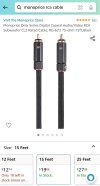Greetings folks - this is probably a very silly question, but I'm hoping the answer will be equally silly.
I'm currently on the FM9 Wait list, and in the meantime I'm doing research and setting up the infrastructure in my studio setup to best support it when that glorious email arrives. To that end, I bought a PreSonus Studio 68c interface specifically for the S/PDIF I/O to use with the FM9. (Yes, I know it will not directly monitor, and I'm alright with that)
So, my question is - what qualities should I be looking for in RCA cables to be used specifically for S/PDIF (if there are any). I'm looking at about a 15 foot cable run.
Many thanks in advance for your educated/opinionated replies!
I'm currently on the FM9 Wait list, and in the meantime I'm doing research and setting up the infrastructure in my studio setup to best support it when that glorious email arrives. To that end, I bought a PreSonus Studio 68c interface specifically for the S/PDIF I/O to use with the FM9. (Yes, I know it will not directly monitor, and I'm alright with that)
So, my question is - what qualities should I be looking for in RCA cables to be used specifically for S/PDIF (if there are any). I'm looking at about a 15 foot cable run.
Many thanks in advance for your educated/opinionated replies!

